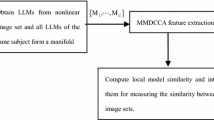Abstract
In this paper, a new feature extraction algorithm is developed based on canonical correlation analysis (CCA), called Local Discrimination CCA (LDCCA). The method considers a combination of local properties and discrimination between different classes. Not only the correlations between sample pairs but also the correlations between samples and their local neighborhoods are taken into consideration in LDCCA. Effective class separation is achieved by maximizing local within-class correlations and minimizing local between-class correlations simultaneously. Besides, a kernel version of LDCCA (KLDCCA) is proposed to cope with nonlinear problems in experiments. The experimental results on an artificial dataset, multiple feature databases and face databases including ORL, Yale, AR validate the effectiveness of the proposed methods.
Similar content being viewed by others
Explore related subjects
Discover the latest articles and news from researchers in related subjects, suggested using machine learning.References
Hotelling H (1936) Relation between two sets of variates. Biometrika 28(3): 321–377
Gao H, Hong W, Cui J, Xu Y (2007) Optimization of principal component analysis in feature extraction. In: IEEE international conference mechatronics and automation, pp 3128–3132
Zheng W, Zhou X, Zou C et al. (2006) Facial expression recognition using kernel canonical correlation analysis. IEEE Trans Neural Netw 17(1): 233–238
Nielsen AA (2002) Multiset canonical correlations analysis and multispectral truly multitemporal remote sensing data, image processing. IEEE Trans Image Process 11(3): 293–305
Vlassis N, Motomura Y, Krosa B (2000) Supervised linear feature extraction for mobile robot localization. In: Proceedings of the IEEE international conference on robotics and automation, pp 2979–2984
Melzer T, Reiter M, Bischof H (2003) Appearance models based on kernel canonical correlation analysis. Pattern Recognit 36(9): 1961–1971
Abraham B, Merola G (2005) Dimensionality reduction approach to multivariate prediction. Comput Stat Data Anal 48(1): 5–16
Horikawa Y (2004) Use of autocorrelation kernels in kernel canonical correlation analysis for text classification. In: International conference on neural information processing, pp 1235–1240
Hardoon DR, Szedmak S, Shawe-Taylor J (2004) Canconical correlation analysis: an overview with application to learning methods. Neural Comput 16(12): 2639–2664
Li Y, Shawe-Taylor J (2006) Using KCCA for Japanese–English cross-language information retrieval and document classification. J Intell Inf Syst 27(2): 117–133
Fukumizu K, Bach FR, Gretton A (2007) Statistical consistency of kernel canonical correlation analysis. J Mach Learn Res 8: 361–383
Farquhar JDR, Hardoon DR, Meng H, Shawe-Taylor J, Szedmak S (2005) Two view learning: SVM-2K, theory and practice. Adv Neural Inf Process Syst
Hsieh W (2000) Nonlinear canonical correlation analysis by neural network. Neural Netw 13(10): 1095–1105
Kambhatla N, Leen TK (1997) Dimension reduction by local principal component analysis. Neural Comput 9: 1493–1516
Roweis ST, Saul LK (2000) Nonlinear dimensionality reduction by locally linear embedding. Science 290: 2323–2326
Tenenbaum J, de Silva V, Langford JC (2000) A global geometric framework for nonlinear dimensionality reduction. Science 290: 2319–2323
He X, Niyogi P (2003) Locality preserving projections. Adv Neural Inf Process Syst 16, Vancouver, Canada
Sun T, Chen S (2007) Locality preserving CCA with applications to data visualization and pose estimation. Image and Vis Comput 25(5): 531–543
Sun T (2006) Enhanced canonical correlation analysis and application. PhD dissertation, Nanjing University of Aeronautics and Astronautics
Shawe-Taylor J, Williams CKI, Cristianini N, Kandola JS (2005) On the eigenspectrum of the gram matrix and the generalization error of kernel-PCA. IEEE Trans Inf Theory 51(7): 2510–2522
Bach FR, Jordan MI (2002) Kernel independent component analysis. J Mach Learn Res 3: 1–48
Bach FR, Jordan MI (2002) Learning graphical models with mercer kernels. In: Neural information processing systems, vol 15, pp 1009–1016
Turk M, Pentland A (1991) Eigenfaces for recognition. J Cogn Neurosci 3(1): 17–166173
Belhumeour PN, Hespanha JP, Kriegman DJ (1997). Eigenfaces vs. Fisherfaces: recognition using class specific linear projection. IEEE Trans Pattern Anal Mach Intell 19(7): 711–720
Sun Q, Jin Z, Heng PA, et al. (2005) A novel feature fusion method based on partial least squares regression. In: International conference on advances in pattern recognition, pp 268–277
Sun Q, Zeng S, Liu Y, Heng PA, Xia DS (2005) A new method of feature fusion and its application in image recognition. Pattern Recognit 38(12): 2437–2448
Via J, Santamaria I, Perez J (2007) A learning algorithm for adaptive canonical correlation analysis of several data sets. Neural Netw 20(1): 139–152
Sun T, Chen S, Yang JY, Shi P (2008) A novel method of combined feature extraction for recognition. In: IEEE conferences on data mining, pp 1043–1048
Author information
Authors and Affiliations
Corresponding author
Rights and permissions
About this article
Cite this article
Peng, Y., Zhang, D. & Zhang, J. A New Canonical Correlation Analysis Algorithm with Local Discrimination. Neural Process Lett 31, 1–15 (2010). https://doi.org/10.1007/s11063-009-9123-3
Published:
Issue Date:
DOI: https://doi.org/10.1007/s11063-009-9123-3




